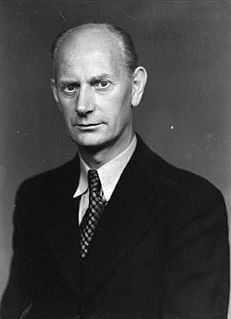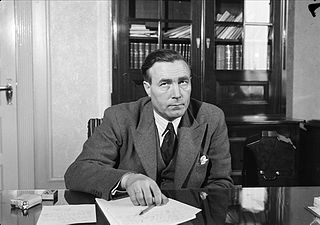
Einar Henry Gerhardsen was a Norwegian politician from the Labour Party of Norway. He was Prime Minister for three periods, 1945–1951, 1955–1963 and 1963–1965. With 17 years in office, he is the longest serving Prime Minister in Norway since the introduction of parliamentarism. Many Norwegians often refer to him as "Landsfaderen" ; he is generally considered one of the main architects of the rebuilding of Norway after World War II. He also served as the second President of the Nordic Council in 1954.

Trygve Martin Bratteli (help·info) was a Norwegian newspaper editor and politician with the Norwegian Labour Party. He served as Prime Minister of Norway from 1971–1972 and 1973–1976. He was President of the Nordic Council in 1978.

Oscar Fredrik Torp (help·info) was a Norwegian politician for the Norwegian Labour Party. He was party leader from 1923 to 1945, and mayor of Oslo in 1935 and 1936. In 1935 he became acting Minister of Defence in the government of Johan Nygaardsvold. He was also Minister of Social Affairs from 1936 to 1939, and then Minister of Finance from 1939 to 1942. He was appointed Minister of Defence again in 1942 in the London-based Norwegian exile government. He continued until the election in 1945 when he became Minister of Provisioning and Reconstruction until 1948.

Johan Nygaardsvold was a Norwegian politician from the Labour Party who served as Prime Minister of Norway from 1935 to 1945. From 1940 until 1945, he oversaw the Norwegian Government-in-exile from London as head of the Nygaardsvold cabinet during the Occupation of Norway by Nazi Germany.

The Labour Party, formerly the Norwegian Labour Party, is a social-democratic political party in Norway. It was the senior partner of the governing red–green coalition from 2005–2013 and its leader Jens Stoltenberg served as Prime Minister. The party is currently led by Jonas Gahr Støre.

The Centre Party is an agrarian centrist political party in Norway. Founded in 1920 as the Nordic agrarian Farmers' Party, the party's policy is not based on any of the major ideologies of the 19th and 20th century. It has a focus on maintaining decentralised economic development and political decision-making.

The Kings Bay Affair was a political issue in Norway that reached its apex in 1963 and brought down the government of Einar Gerhardsen and formed the basis for non-socialist coalition politics in Norway that persisted to the end of the 20th century. The affair was a dramatic episode in Norwegian history that portended the end of the Gerhardsen dynasty and the emergence of a more articulate and coherent political alternative in the non-socialist camp. It is also credited with galvanizing the radical socialist wing of Norwegian politics in time for the EU debate nine years later.
Hans Julius Gabrielsen was a Norwegian jurist and politician for the Liberal Party. He is best known as County Governor of Finnmark and County Governor of Oppland, as well as Consultative Councillor of State for Finnmark Affairs in 1945.
Kirsten Hansteen was a Norwegian editor and librarian. She was appointed Minister of Social Affairs with Gerhardsen's First Cabinet in 1945 and was the first female member of cabinet in Norway.

Nils Hjelmtveit was a Norwegian educator and politician for the Labour Party. He was mayor of Stokken, MP from 1925 to 1930, Minister of Education and Church Affairs from 1935 to 1945 and County Governor of Aust-Agder from 1945 to 1961.

Olav Meisdalshagen was a Norwegian politician for the Labour Party best known for serving as the Norwegian Minister of Finance from December 1947 to November 1951 and as the Norwegian Minister of Agriculture from January 1955 to May 1956. He was also a Member of Parliament for a long time, being elected for the first time in parliamentary election of 1936 and serving until his death, except for the period between 1940 and 1945 when the Parliament of Norway was de facto defunct due to the occupation of Norway by Nazi Germany. His death in 1959 came halfway through his fifth term in Parliament, and shortly after a parliamentary speech.

Harald Viggo Hansteen was a Norwegian lawyer. He was executed during the Occupation of Norway by Nazi Germany.

Nygaardsvold's Cabinet was appointed on 20 March 1935, the second Labour cabinet in Norway. It brought to an end the non-socialist minority Governments that had been dominating politics since the introduction of the parliamentary system in 1884, and replaced it with stable Labour Governments that, with the exception of during World War II, would last until the coalition cabinet Lyng in 1963.
Events in the year 1945 in Norway.

The Lyng Cabinet governed Norway between 28 August 1963 and 25 September 1963. It was the first in 28 years not to be led by the Norwegian Labour Party. It was a centre-right coalition government of the Conservative Party, Centre Party, Christian Democratic Party and Liberal Party led by John Lyng of the Conservative Party. It had fifteen members, of which five were from the Conservative Party, four were from the Centre Party, three were from the Christian Democratic Party and three were from the Liberal Party. Karen Grønn-Hagen was the cabinet's only female member.
Jens Mogens Boyesen was a Norwegian diplomat and politician for the Labour Party.
In Norway, a State Secretary is a partisan political position within the executive branch of government. Contrary to the position Secretary of State in many other countries, the Norwegian State Secretary does not head his or her Ministry, rather, they are second in rank to a Minister. Resembling a de facto vice minister, the State Secretary, however, cannot attend a Council of State, and does not act as a temporary Minister in case of illness or other leave of absence.
Labour government or Labor government may refer to:












